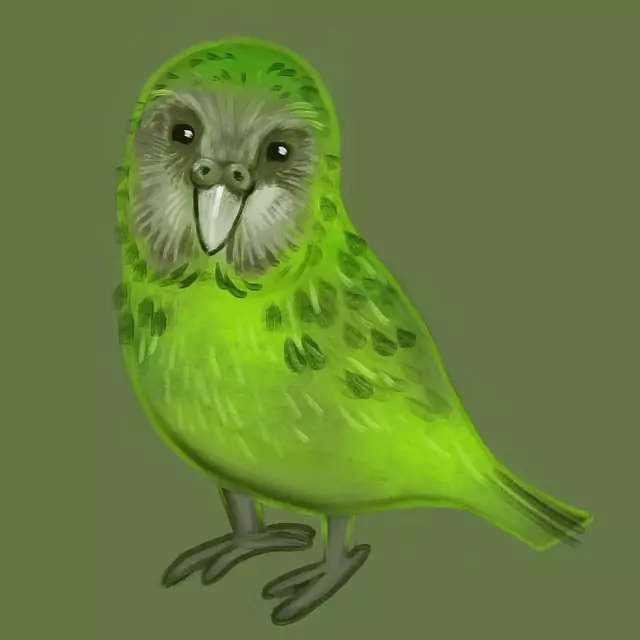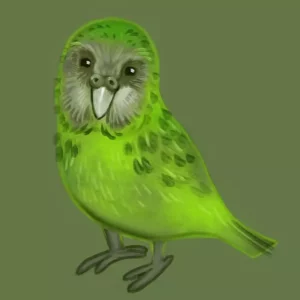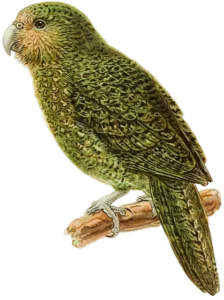0

The kakapo bird is a large flightless parrot. It lives on isolated New Zealand islands. And is now extremely vulnerable due to predation and human encroachment.
One of the most fascinating animals in the world is the kakapo bird. Their almost prehistoric appearance makes them stand out. Like a sore feather and they are the heaviest parrot species on Earth.
Large parrots of the kakapo species are native to the islands of New Zealand.
The weirdly endearing kakapos’ adoration comes from their amiable dispositions and tranquil temperament.
But, there’s a chance that these non-flying birds won’t survive. Fortunately, environmentalists have intervened. They are making efforts to guarantee that we don’t lose these species forever.

These gentle giants consume seeds, nuts, fruits, and flowers. And they range in weight from four to nine pounds.
The islands of New Zealand are home to the kakapo. Their unusual appearance comes from their Latin name. Strigops habroptilus, which roughly translates to “owl-face soft-feather.”
They are frequently referred to as “owl parrots.” This is because of this resemblance to owls. Despite the fact that genetic analysis has shown that the two are not closely related.
They also practice this ancient wisdom thing. You get the impression that this species has been present for a very long time. And is somewhat isolated in the contemporary day.
Due to their nocturnal habits, kakapos are a different species of parrot. And they go by the moniker “night parrot.” They are by far the biggest parrot species in the world, weighing four to nine pounds on average.
These owl parrots eat seeds, nuts, fruits, and flowers as well as rimu fruit, which has high vitamin D concentrations and is crucial for their growth. However, rimu fruit is their favorite diet.
As one of the largest flightless bird species in the world, kakapos are incapable of flight.
Furthermore, the moniker “owl parrot” came from the Kakapo’s face, which resembles an owl.
Kakapo birds have developed powerful legs to compensate for their weak wings, allowing them to move fast and climb up forest trees. They spread out their tiny wings to “parachute” to the earth when they need to come back down.
Kakapos lead leisurely lifestyles and begin reproducing at extremely late ages—four years for males and six years for females. They may have the longest life expectancy among birds with a lifespan of over 90 years.
The kakapo, despite having huge features, has a naturally kind disposition. The native Mori people and early island settlers frequently kept them as pets.
Sadly, the kakapo’s calm demeanor may have contributed to the endangerment of its species in some small way.
The majority of New Zealand was uninhabitable prior to the 13th century. There were no predators there. So the kakapos could live in relative safety among the island’s lush forests. Their population grew rapidly.
Then people arrived, infecting the island with illness and invading mammals. The settlers’ dogs, cats, and rat species presented a wide variety of new predators to the kakapos. The kakapos’ traditional method of avoiding potential hazards by remaining motionless was no longer effective.
Kakapos were suddenly in danger of being eaten as well. The early immigrants “devoured the kakapo, used their feathers to weave cloaks, and carved their bones into fish hooks.”
To save the native bird’s extinction, the New Zealand government established the Kakapo Conservancy Program in the 1980s.
When European colonists began to settle on the islands in the 18th century, things deteriorated.
Numerous additional predators, including two new species of rats, stoats, weasels, possums, and ferrets, were synonymous with the colonists. The kakapo population was drastically reduced, whilst the invading species flourished.
There are currently only 211 kakapos left.
The native bird species of New Zealand, including the kakapo, once had a very high level of biodiversity. However, many of those species are now extinct. A 2020 study claims that humankind has wiped away 50 million years of evolution in New Zealand in just a few hundred years.
The choices we make today on conservation will have an impact on the planet for millions of years to come.
Some people think that if you leave nature alone, it will rapidly recover. However, at least in New Zealand, nature would take many million years to recover from human acts, and may never truly recover.

Lastly, one of the world’s largest species of birds that cannot fly or hover is the kakapo.
Without drastic conservation measures, it was obvious by the 1980s that the kakapo would go extinct.
The Kakapo Recovery Program was born by the New Zealand Department of Conservation. It involves cleaning the nation’s islands of predators and moving the current birds to these areas.
The four predator-free New Zealand islands of Anchor, Whenua Hou, Hauturu, and Chalky are the only places where the kakapo can still be found today.
Here, kakapo conservationists work on the breeding program for critically endangered birds.